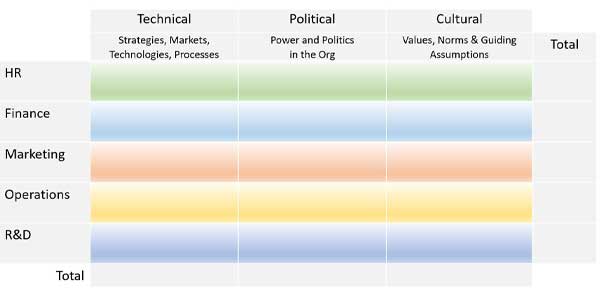
by Rick Stomphorst
This blog touches on the unanticipated findings during your on-boarding process.
You understood your new company to be mature yet you’re discovering it to be very immature. You’ve discovered there are few documented processes, everyone seems to be fighting fires and there isn’t a HR policy manual. Or vise versa, everything has a documented procedure and there is no room for innovation.
You have a fixed amount of time to investigate a new employer during the interview period. Performing an exhaustive research to make an 100% informed decision about the new employer is impossible. For example, during a merger or acquisition, professionals using a tried & true process to research the to-be-acquired company, and they still can’t find everything. You research the company in the time allotted and to the best of your abilities.
STARS
Businesses exist in one of four phases of in their lifespan, which Author Michael Watkins refers to the STARS model:
- Startup
- Turnarounds
- Accelerated Growth
- Realignment
- Sustaining success
Startup – The company is trying to launch a new business, product or service. Limited financial resources, employees are usually less focused on key issues, there is ongoing excited confusion, your assembling startup’s capabilities, corporate memory is virtually non-existent – residing with a few key resources – the company’s primary goal is often fiscal survival. You must channel the excited confusion into a productive direction. You need measurable goals and create value, often requiring tough calls. By definition, startups are on the offensive requiring hunter type management.
Turnaround – Stakeholders know what the problems are, but not what to do about it. For example, the product is at end-of-life with no replacement in sight or a competitor has been relentlessly eating away at your business greatly eroding the financial viability of the business, but at least the team recognizes the consequences and they are hungry for hope. At any given time, between 20 and 30 percent of all companies are in need of a turnaround (J. Murphy 1986). Staff may be demoralized. You need to teach people the need for change and about the problems. Your business, process or product takes on a defensive strategy. You have one goal, which is to get to a defendable line, meaning you’ll have to make tough calls. Again, hunter type management is required.
Accelerated Growth – Managing a rapidly growing business. Putting processes and systems in place to enable the business to scale. The growth helps motivate people who will in-turn stretch themselves to achieve objectives.
Realignment – People are unwilling to see the forest for the trees, they are in denial. The challenge is dealing with ingrained cultural norms and convincing employees that change is necessary. You will still likely to have strong people, products or technologies. You have to create a sense of urgency. A farmer management type is needed here. Hunter type management types don’t work well here.
Sustaining Success – This is the plateau companies strive for. Complacency sets in. Innovation slows. You have to create a new challenge to fend off complacency and find new areas to succeed or grow. A farmer management type is needed here to take the company to the next level.
Multiple Phases
It’s not uncommon to find a company existing in multiple phases of a business’s life cycle. Various departments, products or systems/processes may each exist in a different phase. For example
- A Sustaining Success firm could be launching a new product line, which falls into a Startup category,
- A company may have just been acquired by a firm in Turnaround.
You need to identify where each key department, product, or process exists in the STARS model. This will enable you to procedurally tackle the unique issues in each category with a common framework unique to that category.
Take some time to categorize your new situation as this will aid in strategizing your approach to each. Categorize the departments, processes and products as you learn about them.
There is much business literature on the various phases of businesses. If you find your business / department / process / product entrenched in any particular state, suggest learning more about that one specific phase.
<< Previous Blog | Next Blog in Series >>

by Rick Stomphorst
It’s human nature to gravitate towards areas that interest us most. These areas become our preferences. However, these preferences, as it relates to problem solving, may become a blind spot and harm you during on-boarding.
Table 1-2 below, from Watkins’ The First 90 Days, is a simple method for assessing your preferences for different kinds of business problems, for identifying your blind spots. Complete this table by assessing your intrinsic interest in solving problems in the domain in question, not by assessing your skills or experience.

Table 1-2
When complete, transpose the values in these 15 cells into the 15 cells in Table 1-3 below, (again from Watkins’ The First 90 Days). E.g. Green Row1-Column1 to Green Row1-Column1.

Table 1-3
Lastly, calculate the totals. If one column total is noticeably lower than the others, this represents a potential blind spot for you.
The row totals represent your preference for various business functions. For example, if Marketing is low but represents a success criteria for you, you need to be cognizant of that develop a mitigation strategy.
Most people are unable to articulate, or don’t really know their preferences. This method provides you with the means to measure what you enjoy and don’t enjoy working on.
<< Previous Blog | Next Blog >>

by Rick Stomphorst
Excelling at on-boarding at a new job is a skill as it’s common to change roles every 2-3 years. Here are four areas of risks when on-boarding.
1. Aligning your Strengths & Vulnerabilities to the New Role
While it’s typical to blame an on-boarding failure on the new person, failure is never all about mistakes they made. New hires who have been very successful in past roles, can still fail in a new role. A strength you had a previous role may become a weakness in a new role. Failures occur when:
- a new person doesn’t understand or refuses to accept the true situation they find themselves in (reality may have been portrayed differently during the interviews)
- the preexistence of time bombs
- failure to adapt appropriately to the given situation
2. Failure to Build Sufficient Momentum to Establish your Credibility
Failing to build momentum could result in your credibility being eroded during each interaction or meeting. We either gain credibility or lose it.
As the human body treats a virus, so can an organization treat a new hire. The organization’s immune system instinctively could whip into action to isolate then destroy the potentially killer infection (i.e. You).
3. Not using a Systematic Method in your On-boarding
While every on-boarding is unique, there is a high degree of similarities between them. Make on-boarding a repeatable successful process by creating a framework. Each time you switch jobs, your plan will get stronger.
4. Not Aligning your On-boarding to the Current Phase of the Business
The book The 1st 90-Days introduces the STARS model. Companies, departments, products and/or processes exist in one of four phases of existence:
- Startup mode
- Turnaround mode
- Accelerated Growth mode
- Realignment mode
- Sustaining success mode
STARS model allows you to identify and differentiate between the business cycles you’re in, and its related unique characteristics and challenges. The key is to match your on-boarding strategy to the STARS phase of your company.
Assuming a transition takes between 3 – 6 months, over the course of your career you’ll be immersed in on-boarding for 3 – 8 years. A good practice to get good at it.
<< Previous Blog | Next Blog in Series >>

by Rick Stomphorst
As a new employee you need to progress to the point where you’re giving back more to your employer than you’re costing them. In fact, your job may be a risk if you don’t get to the break-even point fast enough.
The actions you take in the first 3 months often dictate your fate: you either succeed or not. You are vulnerable during the first 3 months. You need to build momentum or you will be faced with a mounting up-hill battle.
While transitions and on-boarding’s are fraught with risk, they’re also an important business necessity. Introducing new people to an organization introduces new ideas, preserves vitality, and enables a company to grow.
Feel you’re over your head in your new position? You’re not alone. Some 25% of Managers enter new roles and/or companies each year in Canada. All those transitions will not go well.
The risks are that the new person is unfamiliar with the culture, politics, informal lines of communication, systems and processes, products, markets and the know few people. You are under a microscope.
You’re not the only one transitioning. If in a Management position, your direct reports, in-direct reports, peers, managers and clients are all also in in-direct transition. Additionally, it’s not uncommon to have more than one person in transition or on-boarding at a time within a business, representing an even greater percentage of the staff who are also experiencing in-direct transition and whose performance may be negatively impacted because of it.
Failing an on-boarding or transition is a blemish on your resume. It is also expensive for the hiring company. Some sites note that it can cost a company 24x base compensation for a failed hire.
Value Proposition
Consider how many times in your career you’ll be switching jobs and/or companies. Imagine if you would reduce the break-even point of your on-boarding by a few months each? Best to get good at on-boarding and transitioning.
<< Previous Blog | Next Blog in Series >>

by Rick Stomphorst
You need to determine what to learn and in what order or you’ll be quickly overrun with information. You need a systematic approach.
What do you need to learn cannot be accomplished via adhoc meetings. You will be dragged into enough meetings as that’s the nature of business.
But is that the best approach to on-board yourself? Finding time to learn in a new job is difficult. From day one you are motivated to start contributing 100%. You can expect people will be pressuring you for your time and others will be assessing your authority. Be conscious of what and who you say “no” to.
High-level On-boarding Plan
- Get yourself known, connect, and start building your credibility
- Assess your business situation and strategize accordingly (STARS blog)
- Determine what to learn when (this blog)
- Establish conditions for success (this blog)
- Land early wins
- Assess the company’s alignment with its strategy
- Assess your team and plan any changes to it
- Find and build supporters
- Find the balance between learning and doing
- Recognize that everyone associated with your job is also now in transition, not just you
Failing at anyone of these items may result in you failing overall.
Where to Start
Learn the following of the organization and learn fast. Your tenue may depend on it
- Culture
- Politics
- Lines of communication
- Systems and processes
- Products and/or Services
- Markets
- Uniqueness or differentiator of product(s) and/or services
- Your new staff (if applicable)
- Peers
- Management
Tip: Learning in a Start-up or Turnaround situation is fundamentally technical: products, markets, projects, technologies and strategies. In Realignment or Sustaining Success situations, immerse yourself in to the organizational culture and politics.
Establish Conditions for Success
While you feel the obligation produce at 100% from day-one, avoid this instinctive act. Doing so comes at the expense of being poorly prepared for the greater picture. Even if you were brought in to turnaround a situation, where they want to introduce new ways of doing things, you still need to learn the culture and politics or people won’t accept the change you will propose.
From the company’s side, you may be expected to be past the tipping point very quickly, especially in a start-up or turnaround situation where the luxury of time is not on your or the company’s side.
Determine how much emphasis will you place on learning as opposed to doing.
Determine what can you do to get early wins.
Create a learning plan. Exceptionally few people do, to the determent of their overall on-boarding process. A learning plan doesn’t mean heads-down learning for 12 months. It may mean concentrated learning for the first X weeks then spread out over a year.
Depending on your situation, determine what questions need asking to aid in building your systematic learning plan. For example, “How did the company get to this point?” By asking this basic question, you avoid the risk of undoing something a revered former manager put in place, is working well and represents a source of pride for the staff.
By taking the time to learn what you need to learn, you will be able to make better decisions earlier and reach the break-even point earlier.
<< Previous Blog | Next Blog in Series >>

by Rick Stomphorst
Make a conscious effort to begin and lead your on-boarding. Don’t wait for it to happen.
1. What made you successful in the past won’t guarantee success in your new role. Don’t treat the new role the same as previous roles.
2. Your past strengths could now be a weakness. If you’re transitioning or on-boarding from an individual contributor to manager, be cognizant of a normal tendency to micro manage staff who preform your last function. Remember that you should teach them, coach them, ask opened ended questions of them, but don’t do their job as they’ll come to resent you and feel inadequate.
Be conscious of your problem preferences. i.e. problems you tend to gravitate towards because this plays to your strengths. Will this serve you in your new role? Similarly, be leery of blind spots. For example, do you hate dealing with political HR problems? If so, you need to find a trusted advisor to help with this.
While in the early stages of your career, most people will build up a network of technically savvy advisors (hard skills). However, as you continue up the ladder, you need to identify advisors with soft skills in political council and personal advice.
3. A good practice to establish credibility is planning your on-boarding and sharing the plan with your new manager. The plan should contain goals for each of these periods:
- Before you start
- End of the first day (if you have control over this)
- End of the first week
- End of the first month
- End of month 2
- End of month 3
The plans will be sketchy, but you have demonstrated that you’re not going to allow yourself to be dragged by the nose. It should be written, even if just bullet pints, with priorities, goals, and timelines.
4. Whether you like it or not, some will resent you being at the company/department. There may be those who applied for the job themselves, recommended another candidate, or staff members themselves being transitioned to under your management. Handle with care.
If you’re transitioning within the same company, shed your last role’s responsibilities as quickly as possible. If you keep track you will be surprised that a significant percentage of your time is being allocated to your past responsibilities. Ensure your new manager knows of any lingering demands.
This phase on the on-boarding is a journey, not a destination. Be constantly sure you’re engaging in the right issues.
<< Previous Blog | Next Blog in Series >>








